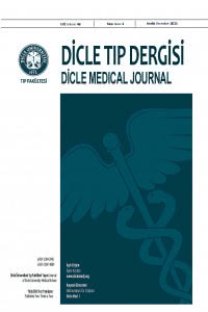Romatoid artrit hastlarında TLR4 geni Asp299Gly ve Thr399Ile polimorfizmlerinin araştırılması
Investigation of the Asp299Gly and Thr399Ile polymorphisms of TLR4 gene in Rheumatoid Arthritis
___
- 1. Spector TD. Rheumatoid arthritis. Rheum Dis Clin North Am 1990; 16: 513–37.
- 2. McInnes IB, Schett G. The Pathogenesis of Rheumatoid Arthritis. N Engl J Med 2011; 365: 2205-19.
- 3. Choy EHS, Panayi GS. Cytokine Pathways and Joint Inflammation in Rheumatoid Arthritis. N Engl J Med 2011; 344: 907-16.
- 4. Yarwood A, Huizinga TWJ, Worthington J. The genetics of rheumatoid arthritis: risk and protection in different stages of the evolution of RA. Rheumatology (Oxford). 2016; 55:199–209.
- 5. Bartok B, Firestein GS. Fibroblast-like synoviocytes: key effector cells in rheumatoid arthritis. Immunol Rev. 2010; 233: 233-55.
- 6. Hu F, Li Y, Shi L, et all. (2014) Toll-Like Receptors Expressed by Synovial Fibroblasts Perpetuate Th1 and Th17 Cell Responses in Rheumatoid Arthritis. PLoS ONE 9(6): e100266. doi:10.1371/journal.pone.0100266
- 7. Molteni M, Gemma S, Rossetti C. The Role of Toll-Like Receptor 4 in Infectious and Noninfectious Inflammation. Mediators of Inflammation Volume 2016, Article ID 6978936, 9 pages
- 8. Zhang B, Ramesh G, Uematsu S, Akira S, Reeves WR. TLR signaling mediates inflammation and tissue injury in nephrotoxicity. J Am Soc Nephrol 2008; 19: 923–32.
- 9. Sabroe I, Parker LC, Dower SK, Whyte MKB, The role of TLR activation in inflammation. J Pathol 2008; 214: 126-135.
- 10. Kutikhin AG. Impact of Toll-like receptor 4 polymorphisms on risk of cancer. Human Immunology 2011: 193-206.
- 11. Lorenz E, Frees KL, Schwartz DA. Determination of the TLR4 genotype using allele-specific PCR. Biotechniques 2001; 31: 22-4.
- 12. Stebulis JA, Rossetti RG, Atez FJ, Zurier RB. Fibroblast-like synovial cells derived from synovial fluid. J Rheumatol 2005; 32: 301-6.
- 13. Gülen F, Köksoy H, Tanaç R, et all. Astım ve alerjik Rinitli Çocuklarda Toll Like Reseptör 2 ve Toll Like Resptör 4 Polimorfizmi. The Journal of Pediatric Research 20014; 1: 13-21.
- 14. Jung YO, Cho ML, Kang CM, et all. Toll-like receptor 2 and 4 combination engagement upregulate IL-15 synergistically in human rheumatoid synovial fibroblasts. Immunol Lett 2007; 109: 21–27.
- 15. Kagan JC, Su T, Horng T, et all. TRAM couples endocytosis of Toll-like receptor 4 to the induction of interferon-beta. Nat Immunol. 2008; 9: 361-8.
- 16. Trejo-de la OA, Torres J, PÊrez-RodrIguez M, et all. TLR4 single-nucleotide polymorphisms alter mucosal cytokine and chemokine patterns in Mexican patients with Helicobacter pylori-associated gastroduodenal diseases. Clin Immunol 2008; 129: 333–40.
- 17. Arbour NC, Lorenz E, Schutte BC, et all. TLR4 mutations are associated with endotoxin hyporesponsiveness in humans. Nat Genet. 2000; 5: 187-91.
- 18. Barber RC, Chang LY, Arnoldo BD, et all. Innate immunity SNPs are associated with risk for severe sepsis after burn injury. Clin Med Res. 2006; 4: 250-5.
- ISSN: 1300-2945
- Yayın Aralığı: 4
- Başlangıç: 1963
- Yayıncı: Cahfer GÜLOĞLU
Pınar ÇİÇEK, ALPER AKIN, Meki BİLİCİ, Mehmet TÜRE, Hasan BALIK, KAMİL YILMAZ
Helikobakter Pilori Pozitifliği İle Nötrofil Lenfosit Oranı ve Mpv İlişkisi
Hipotiroidli Gebe Kadınların Periferik Kanında ANAE ve AcP-az Pozitivitesinin Belirlenmesi
Hasan Hüseyin DÖNMEZ, Fatma ÇOLAKOĞLU, Fatma KILIÇ
Fatma ÇOLAKOĞLU, HASAN HÜSEYİN DÖNMEZ, Fatma KILIÇ
İlknur ÇÖL MADENDAĞ, YUSUF MADENDAĞ, Mehmet AK, ERDEM ŞAHİN, Mefküre ERASLAN ŞAHİN
Prognostic importance of primary tumor location in RAS mutant metastatic colorectal cancer
Nadiye AKDENİZ, MUHAMMET ALİ KAPLAN, Mehmet KÜÇÜKÖNER, Zuhat URAKÇI, Yasin SEZGİN, Senar EBİNÇ, Erkan BİLEN, Oğur KARHAN, Şahin LAÇİN, HÜSEYİN BÜYÜKBAYRAM, Abdurrahman IŞIKDOĞAN
Evaluation of The Occupational Exposures Among Residents in a Tertiary Hospital
HEVAL CAN BİLEK, Hakan LEBLEBİCİOĞLU
The Proper use of Inhalers in a Third Step Hospital and its Effect on Treatment: Original Study
Barış ÇİL, Mehmet KABAK, Ayşe Füsun TOPÇU, Mahşuk TAYLAN, Cengizhan SEZGİ
İstanbul İlinde ABO ve Rh Kan Grupları Dağılımının Analizi
Üçüncü basamak bir hastanede doğru inhaler kullanımı ve bunun tedaviye etkisi: Özgün Çalışma
Mehmet KABAK, Barış ÇİL, Mahşuk TAYLAN, Ayşe Füsun TOPÇU, Cengizhan SEZGİ
